
Packaged food is the quick fix for today’s on- the- go generation. From the early morning biscuits to the breakfast cereal, mid morning chips to post lunch chocolate, evening tea cookies to instant noodles – the list is endless!
Yes, I know you look for reassuring words printed in bold- sugar free, low calorie, fat free, no preservatives, all natural before picking any packaged food item. But those bold claims at the front of your favourite or usual go-to packaged foods can be quite misleading if you don’t read closely. The so called food packets are full of harmful hidden ingredients that are posing hormonal disturbance and other serious health problems and keeping you away from your health goal.
Here we learn handy ways to understand food label ,detect marketing deceptions and make healthful choices:
- Read the ingredient list: Don’t just read the calories. The most important thing to look at FIRST in any packaged food item is the ingredient list, mentioned at the back of the box. The Ingredient List states the main ingredient first(by weight), followed by the rest of the ingredients in descending order(by weight).
For e.g:
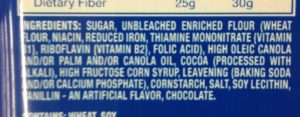
In this particular biscuit packaging, sugar is the biggest component , bigger than even the flour, making it an unhealthy choice .
- Length of the Ingredient List: The fewer the ingredients the better is the packaged food. Would recommend to buy foods with max five or less ingredients. The longer the list, the more questionable the health quotient of the product.
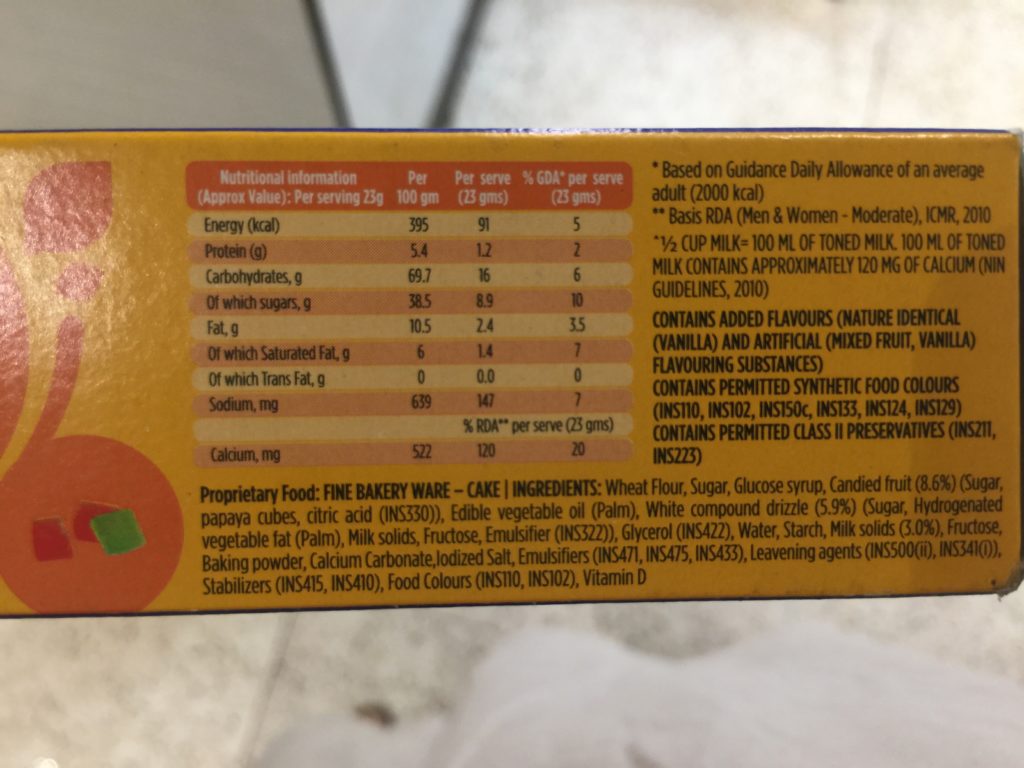
The above packaging is of a popular tea time snack but how many ingredients can you relate with actual food in the long list? Most of ingredients are actually chemicals in form of preservatives, colourings ,emulsifiers and added hidden sugars.
3.Look for real ingredients:In comparison, when you see this label for a sweet granola type product, the list is also long but the ingredients are real making it a better choice. 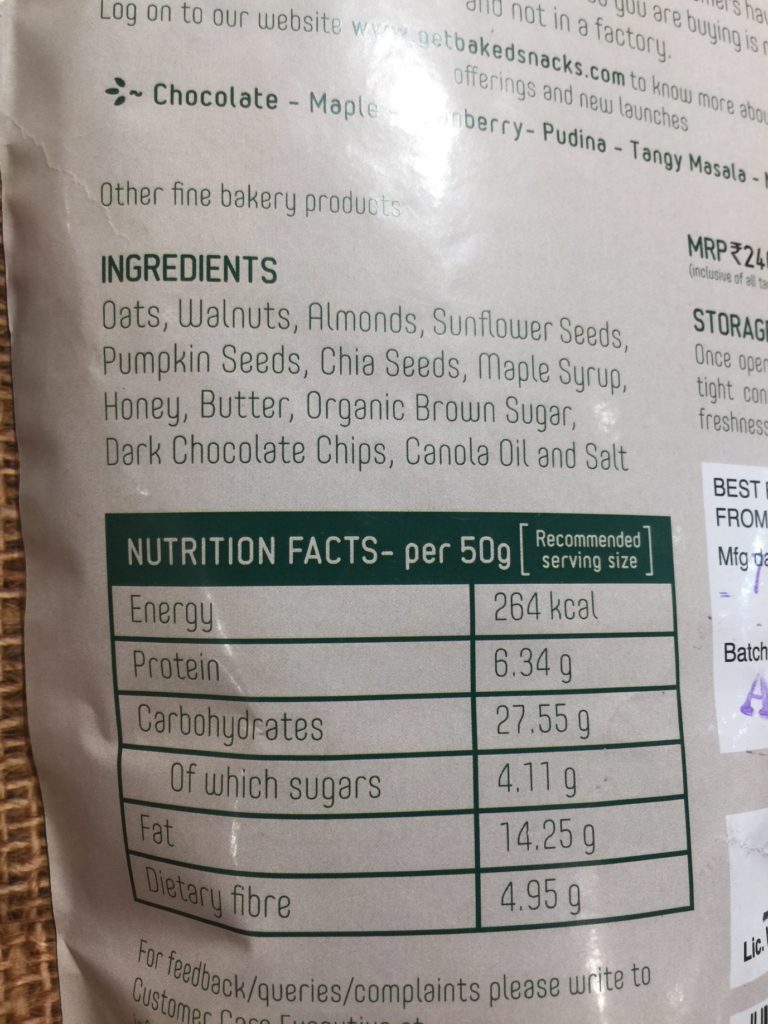
Many times sugars and trans fats are mentioned by different names such as high fructose corn syrup, barley malt, sucrose, maltose, maltodextrin, rice syrup or trans fat as partially hydrogenated vegetable oil. Be wary of such food products.
4.Understanding the Nutrition Facts on the label:
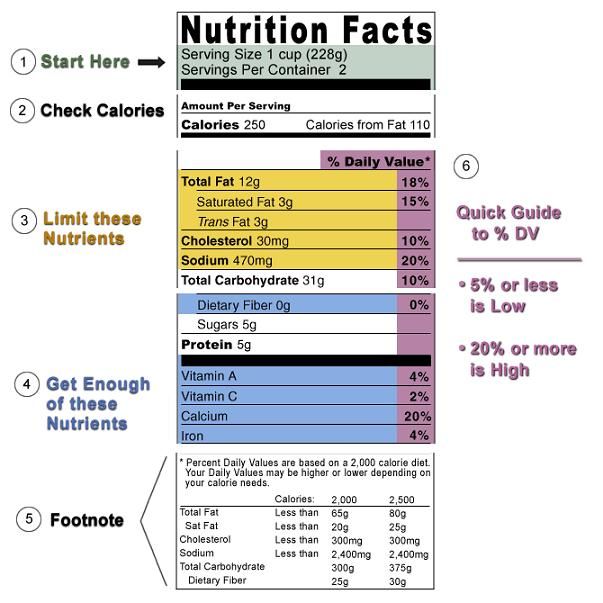
Pic Courtesy: FDA
- Look for Number of Servings Per Container: This tells us the size of a single serving and the total number of servings per container (package).As clearly mentioned there are two servings in the above container and it is not meant to be finished at one go. Next time before having that packet of chips all at one go, check the mentioned number of servings.
- Check the calories per serving and how many servings you’re really consuming: As mentioned in the point above, if you double the servings you eat, you double the calories, fats and carbs too . If you eat whole packet at one go, as per the label above you eat two servings and hence 500 Calories (250*2).Similarly the amount of fat and carbs you ate also doubled the amount mentioned on the label.
- Check for saturated fat,sodium and trans fat:This one is a no-brainer, limit the amounts of saturated fat and sodium, and avoid trans fat Choose foods with as less of these nutrients whenever possible. An important not to be missed point here is, your packet food is not trans fat free even though its label mentions trans fat as 0g. As per FDA, If one serving of any food product contains less than 0.5 gram of trans fat, it is mentioned must as 0 g. As given in the label below, when the Nutrition Facts label says a food contains “0 g” of transfat, but includes “partially hydrogenated oil” in the ingredient list, it means the food contains trans fat, but less than 0.5 grams of trans fat per serving. So, if you eat more than one serving, you could quickly reach your daily limit of trans (as per the American Heart Association). For e.g.
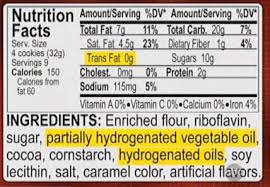
- Secondly, sodium levels are another red flag that you must check. The American Heart Association recommends no more than 1,500 mg per day for most adults. We consume 2,300 milligrams (mgs) a day in 1 teaspoon salt! While we cook with salt levels in check, most of us overdose on sodium from processed, pre-packaged and restaurant foods. This significantly affects blood pressure and heart health.
4.Dietary fiber, protein, calcium, iron, vitamins and other nutrients: These are beneficial nutrients and you may look for them in real whole foods like fresh fruits, vegetables,seeds and nuts and not in packaged foods.
5. Information shown in these panels is based on 2,000 calories/day: Unless you are an athlete or do hard labour, most of us need less than 1600 calorie per day. Hence, most of these values are already on the higher side for us.
6.The % Daily Value (DV) :tells you the percentage of each nutrient in a single serving, in terms of the daily recommended amount. (in this case, in one serving of 228g, this is the percentage of the nutrient that you are consuming.)
To simplify it,use 5:20 ratio rule. If you want to consume less of a nutrient (such as saturated fat or sodium), choose foods with a lower % DV — 5 percent or less. If you want to consume more of a nutrient (such as fiber or protein), seek foods with a higher % DV — 20 percent or more.
I hope this blog helps you making healthier and better food choices . You may find retaining this information overwhelming at one go. I urge you to go point by point and make it a gradual learning process. Do educate your family and your children as well. A nutritionally knowledgeable family is a healthy happy family!
Follow us on fb https://www.facebook.com/UmaNarulaNutriguide/ for regular tips on health,wellness,eat right and much more.
Uma Narula is an award winning practising Nutritionist since 10 years.If you have any queries regarding your health,weight loss and nutrition you can email at uma@nutriguide.co.in or call on +91 99676 35556 / +32 468 29 79 49.
www.umanarula.com